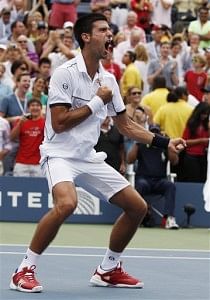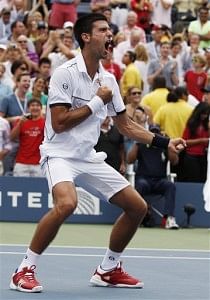
US Open 2011: The luck of the daredevil
In the 2008 Wimbledon final, Roger Federer, down match point in the fourth set tiebreaker against Rafael Nadal, produced a down-the-line backhand winner so gutsy and so electrifying that it almost instantly became the stuff of folklore.
The shot was, simply put, incredible – it reminded us, in the most spectacular manner imaginable, that Federer really, really wanted to win Wimbledon one more time, and it also showed us that the man was so uniquely gifted that he could, somehow, conjure a winning combination despite being hopelessly backed into a corner.
Yesterday, down double match point at 3-5 in the fifth set against Federer, Novak Djokovic unleashed something eerily similar – a blazing forehand return winner that was hit with such monstrous pace that the ball looked like a blur as it dive-bombed into the deuce corner, barely registering with the crowds or even with those watching on high-definition television screens.
Djokovic had come up with something unreal at the unlikeliest of moments, and when he failed to receive any kind of validation for his heroics from the raucously pro-Federer New York crowd, he went so far as to try and exhort the spectators to cheer for him.
But as otherworldly as that shot was, it didn’t seem like a portent of a turnaround – the shot seemed more like the desperate last act of a man who had abandoned all common sense and caution than a calculated risk by a player fighting hard to make a comeback.
We should have known better, of course.
Federer went on to squander another match point (this time to a net-cord ball that bounced out) before getting broken, and Djokovic, in barely believable fashion, proceeded to defeat the 16-time Slam champion in the US Open semifinals after having averted two match points for the second straight year.
Federer’s backhand at Wimbledon in 2008, while breathtaking and appropriately celebrated, wasn’t enough to win him the match. Djokovic’s return winner yesterday, a product of pure passion and intensity, took him all the way to the finish line.
And that, right there, is what sets apart Djokovic’s play this year, and gives credence to the speculation that right now, his game has reached a peak that has never been seen in the sport before.
When asked about Djokovic’s game-changing forehand after the match, Federer said that he thought that it was a ‘lucky’ shot. He also said that, having been a bit of a slacker in his early days, he had learned the value of discipline the hard way, to the point that he himself would never have even contemplated attempting such a brazenly daredevil shot on match point.
Federer was partly right on both counts. He might have considered using a word more tactful than ‘lucky’ to describe Djokovic’s shot, but there’s no doubt that 99 times out of 100, a shot like that would have flown past the sidelines and handed the match to the opponent. And yes, Federer is so vastly talented that most of the times, playing within himself, rather than going for broke, is his best bet to get out of a crunch situation.
In a way, though, Federer’s somewhat uncharitable assessment of the situation adds even more mystique to Djokovic’s exploits. It’s been said that modern tennis players, aided by superior racquet technology and slower courts, have pushed the boundaries of athleticism, power and speed (of which Djokovic and Nadal are the prime examples). Djokovic’s play yesterday may have been an instance of something even more – pushing the physical as well as the mental boundaries of the sport.
Lost amidst the brouhaha over the shot (should we come up with a name for it? How about ‘The Daredevil Forehand’?) is the fact that the formula Djokovic used to keep Federer at bay through the last three sets was thoroughly unimaginative, and yet thoroughly reliable.
In the first two sets, the match had a typical Federer-Djokovic quality to it – lots of fast, thundering groundstrokes, bruising back-and-forth exchanges, quality serving and relentless running. There was very little to choose between the two, but Djokovic made an odd error here and there on important points, while Federer’s play, save for that double fault at 5-2 in the 1st set tiebreaker, was as solid as it had been all tournament – very few mistakes off the backhand, and a forehand that produced more winners than errors (which is often all that Federer needs to do to win).
And then, without warning, everything changed the moment the third set began. Having conceded a two-set lead, Djokovic probably realized he had nothing to lose, and he began to hit out. He also remembered that it isn’t such a bad ploy to attack Federer’s backhand remorselessly.
Federer’s serve was broken at the start of the third set, and that was all the encouragement needed for the now-infamous backhand shanks to come out in full force. Djokovic’s two-handed backhand may not have the vicious topspin that Nadal generates on his forehand, but it travels quicker through the court.
The results, in any case, aren’t all that different – just like Nadal uses his forehand, Djokovic used his backhand to attack Federer’s backhand with a vengeance, and just like in his matches against Nadal, Federer’s one-hander broke down. How long will it be before the one-handed backhand disappears completely from the sport?
There was no reason to expect the fifth set to unfold any differently from the previous two sets, but that’s when Federer decided to give us one final reminder of his place in the history of the game. Realizing that trying to hang with Djokovic in the backhand-to-backhand rallies was a lost cause, Federer chose, perhaps wisely, to circumvent the problem rather than solve it. He used his superlative movement to almost completely mask the deficiency in his game, repeatedly going around the backhand to strike emphatic forehands that scorched the court and left the spectators gasping.
On the few occasions that Djokovic succeeded in getting the ball with anything resembling pace to Federer’s backhand, the point was as good as over. It’s a mark of just how great Federer’s forehand that, armed with basically one groundstroke, he still managed to stay with, and almost defeat, a player who’s in the middle of possibly the greatest season ever.
As I watched the fifth set heat up, I wondered for how long Federer could keep up with running around the backhand before the forehand broke down too. He certainly kept it up for longer than I expected – he rode his fiery forehand all the way to 5-3 and a chance to serve out the match. Unfortunately for him, that’s when the Daredevil Forehand decided to show up.
For people who have followed Federer’s career through all its ups and downs, there’s only one question that really matters here – did Federer choke? While he couldn’t really have done anything about the first match point, the second botched match point, as well as the double fault to give up the break in that game, were clearly caused by nerves. And yet, it is difficult to imagine him being in that situation if his backhand hadn’t let him down in the first place.
What must be truly disconcerting to his camp, though, is that his backhand was not the only thing that came up short yesterday. Federer’s return of serve, the shot most likely to be affected by slightly slowed reactions, has become distinctly subpar, especially when compared with the amazingly consistent returns of the other top-5 players. He conceded a host of free points to Djokovic yesterday by failing to put Djokovic’s serve, which was solid throughout the match, back into play.
Federer himself, on the other hand, won only a handful of free points on his serve because Djokovic’s accuracy with his returns was just, well, scary. There are weaknesses in Federer’s game today that are as glaring as they are easy to exploit. And it’s a lot simpler to choke when you know you have limited options to rely upon to get you out of trouble.
While I’ve been focusing on the reasons why Federer lost yesterday, the most important development that emerged out of the match has nothing to do with Federer. We’re living in the Year of Djokovic, and it keeps getting more ridiculous by the day. His game has become so unerringly watertight that it refuses to come apart come hell or high water.
There is just no place to go to against Djokovic this year – he seems to have transcended things like fatigue, loss of form, overconfidence and even discouragement in the face of seemingly insurmountable obstacles (two sets to love down? No biggy. Two match points down? Piece of cake). Is he invincible?
Tomorrow’s final against Nadal will answer that question one way or another. And if he manages to hit another Daredevil Forehand on match point in the final, it won’t be because of luck. It will be because he’s earned it.

